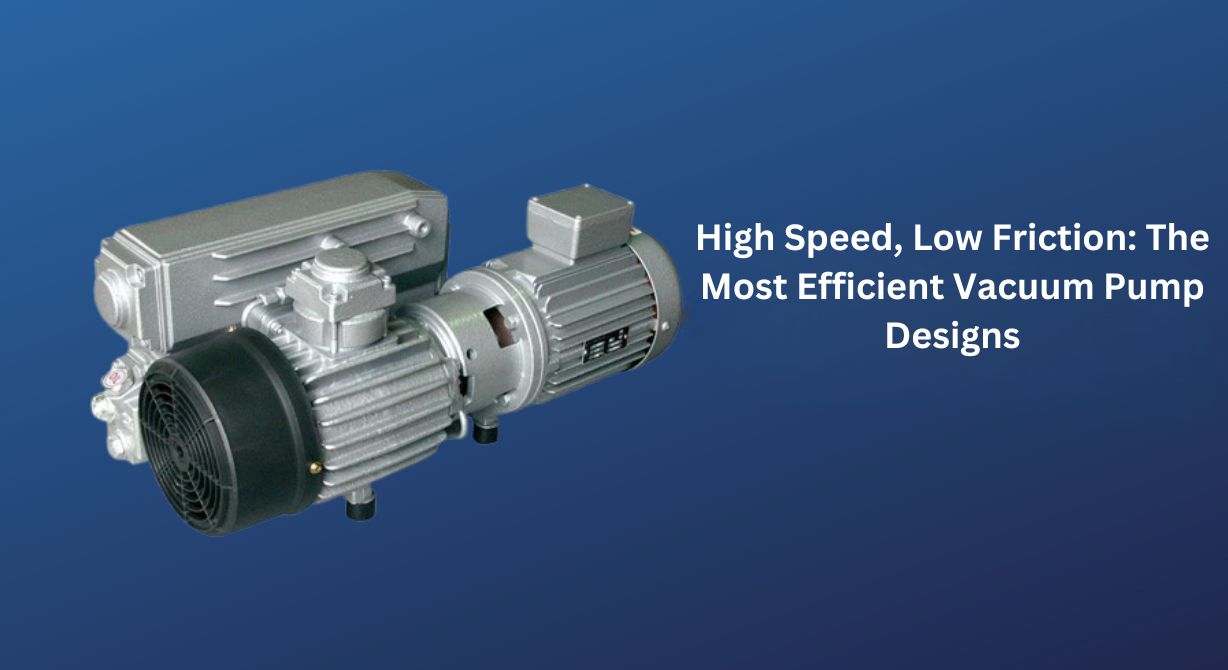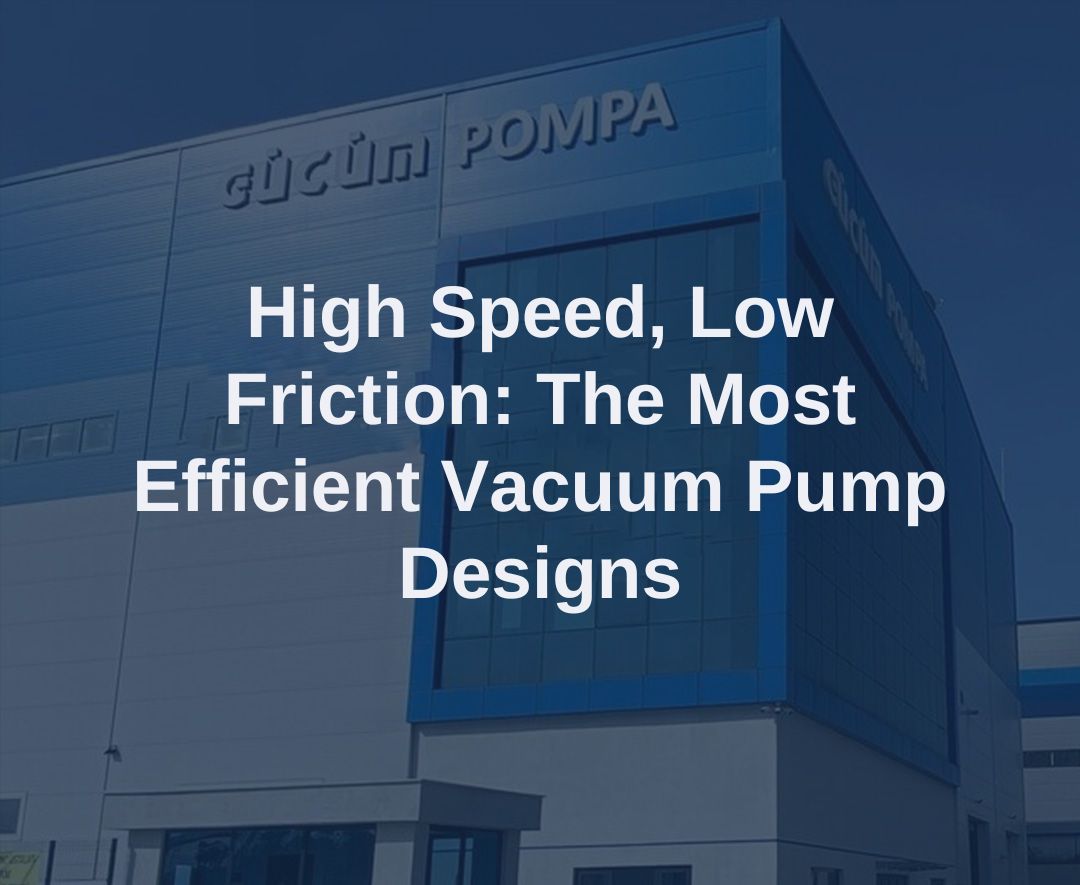High Speed, Low Friction: Most Efficient Vacuum Pump Designs
Table of Contents
- High Speed, Low Friction: How Do the Most Efficient Vacuum Pump Designs Work?
- Balancing Speed and Friction in Vacuum Pump Design: How to Boost Your Performance?
- Top Vacuum Pump Designs: The Secret of High Speed and Low Friction
- Ways to Reduce Friction in High-Speed Vacuum Pumps
- Performance Beast: Comparing Low-Friction Vacuum Pump Designs
- Why Low Friction Is the Key to Vacuum Pump Efficiency?
High Speed, Low Friction: How Do the Most Efficient Vacuum Pump Designs Work?
In industrial processes, vacuum pumps play a critical role in terms of efficiency and performance. Especially high speed and low friction features directly affect the operating effectiveness of pumps. These two factors are the main focus in modern vacuum pump designs. So, how do these designs work and why are they more efficient than other models?
Firstly, high-speed vacuum pumps achieve higher performance with less energy consumption thanks to the optimized structure of rotors and other moving parts. The biggest challenge here is that as speed increases, friction shortens the pump's lifespan. Therefore, low-friction materials and precise engineering techniques are used. For example, special coatings and low-friction bearing systems minimize wear, providing long-lasting use.
In addition, aerodynamic design principles optimize the internal fluid movements of pumps. This reduces energy losses and increases pump efficiency. Today, innovative solutions like magnetic bearing technology significantly lower friction, allowing quiet and stable operation.
Another factor increasing efficiency is advanced control systems and sensor integration. These systems monitor the pump’s operating conditions in real time, ensuring performance stays at an optimum level. At the same time, they simplify maintenance processes and reduce failure risks.
In summary, vacuum pumps designed with the principles of high speed, low friction consume less energy in the industry while delivering higher performance. This creates significant advantages both in terms of cost and environmental impact.
Balancing Speed and Friction in Vacuum Pump Design: How to Boost Your Performance?
In vacuum pump design, the balance between speed and friction is the main determinant of performance. High speed enables the pump to draw more air or gas, but as speed increases, friction also rises, leading to heat buildup and energy losses. Therefore, when optimizing vacuum pump performance, these two factors must be balanced precisely.
Modern designs use low-friction materials and advanced engineering techniques to reduce friction-related energy loss. Especially magnetic bearing systems and special coatings minimize contact between moving parts, extending the pump’s lifespan and increasing energy efficiency.
At the same time, aerodynamic optimization regulates the air flow inside the pump, limiting the effects of friction. This prevents unnecessary energy use while maximizing performance. Designers manage potential friction issues brought by higher speeds in this way.
Additionally, smart control systems analyze real-time data, continuously monitoring the pump's operating speed and temperature. Thus, performance losses are prevented and maintenance needs are detected early. These technologies enhance both the reliability and efficiency of the pump.
In summary, the balance between speed and friction is the key to improving performance in vacuum pump design. Material selection, aerodynamic structure, and smart system integration are critical to achieving this balance.
Top Vacuum Pump Designs: The Secret of High Speed and Low Friction
In vacuum pump design, the combination of high speed and low friction is an essential element of industrial efficiency. A well-designed vacuum pump delivers maximum performance while keeping energy consumption and mechanical wear to a minimum. Achieving this balance is one of the top concerns for designers.
In particular, material selection plays a critical role here. Modern vacuum pumps use low-friction coatings and high-strength alloys to significantly reduce friction rates, extending pump life and maintaining consistent performance.
Additionally, aerodynamic design elements optimize air flow, increasing pump speed while reducing energy losses caused by friction. For example, rotor geometry and air channels are configured to create maximum vacuum with minimal resistance.
Innovative technologies like magnetic bearing systems prevent direct contact between moving parts, greatly reducing friction. This allows the pump to run both quieter and more efficiently.
Finally, vacuum pumps supported by smart sensors and data analytics enable real-time performance monitoring, continuously controlling optimal speed and friction values. This technology reduces failure risk and minimizes maintenance costs.

Ways to Reduce Friction in High-Speed Vacuum Pumps
Reducing friction in high-speed vacuum pumps is critical for performance and durability. The lower the friction, the more efficiently the pump operates and the lower the risk of mechanical wear. Therefore, designers and engineers focus on various methods to minimize friction.
Firstly, material selection is highly important. Coatings with low friction coefficients and high-quality alloys reduce the contact between moving parts. For example, Teflon coating or carbon-based materials are often preferred.
Secondly, design optimization directly affects friction. Rotor geometry and bearing systems should be designed to provide minimal surface contact. Magnetic bearing technologies almost completely remove physical contact between parts, nearly eliminating friction issues.
Thirdly, lubrication techniques are also an important way to reduce friction. Using suitable and quality oils allows moving parts to move more freely and slows down wear. Additionally, cooling systems keep pump temperature under control, preserving oil performance.
Finally, with advanced sensor technologies and data analytics, friction and performance are continuously monitored, enabling instant intervention when necessary. This approach guarantees long-lasting and efficient pump operation.
Performance Beast: Comparing Low-Friction Vacuum Pump Designs
In vacuum pumps, low friction is the key to high performance. There are various vacuum pump designs on the market, each offering different technologies and advantages. In this article, we’ll compare the main differences and performance improvement methods of low-friction vacuum pumps.
Firstly, magnetic bearing pumps almost completely eliminate friction, providing quiet and long-lasting operation. The absence of physical contact reduces energy loss while also minimizing maintenance needs. However, they come with a higher price tag compared to other models.
On the other hand, ceramic-coated rotor pumps are widely preferred in the industry due to their combination of high durability and low friction. Ceramic material reduces wear and increases pump efficiency. These designs perform especially well in high-temperature and chemical environments.
Hybrid designs aim to reduce both friction and wear by combining magnetic bearing technology with durable materials like ceramic coatings. This combination offers an ideal cost-performance balance for medium and high-performance applications.
Finally, classic pumps upgraded with advanced lubrication systems have also been modernized to boost performance. Especially nano-technology-based lubrication products reduce friction, extend pump life, and increase energy efficiency.
When choosing between different vacuum pump designs, factors like usage area, budget, and ease of maintenance should be considered. Low-friction technologies stand out as an indispensable criterion for performance beast pumps.
Why Low Friction Is the Key to Vacuum Pump Efficiency?
In vacuum pumps, low friction is the main determinant of efficiency. Friction represents the energy loss occurring between the pump’s moving parts, and this loss increases energy consumption while shortening the pump’s lifespan. Therefore, minimizing friction is a must for vacuum pump efficiency.
Low friction reduces mechanical wear inside the pump, lowering maintenance costs. At the same time, it limits heat generation during operation; this keeps the system running more stably and reduces failure risk. Especially in high-speed vacuum pumps, friction control becomes a critical factor for performance and durability.
Modern pump designs minimize friction with technologies like magnetic bearings or special coatings. These technologies allow parts to operate without direct contact, significantly reducing energy loss. As a result, the pump uses less energy and becomes a more eco-friendly option.
Increased efficiency not only saves energy but also improves business continuity. Low-friction pumps require less maintenance and prevent unexpected failures. This is especially important in industrial applications for keeping production lines running without interruption.
In summary, vacuum pump efficiency requires low friction—not as an option but as a necessity. This approach offers advantages in terms of both cost and performance and is now accepted as standard in future pump technologies.


